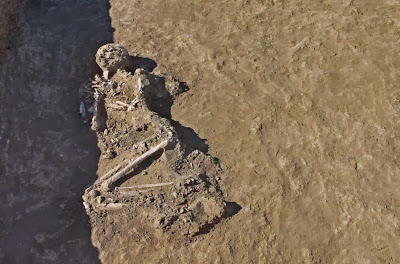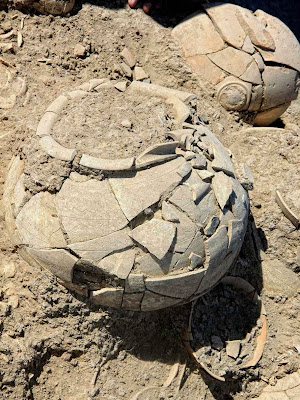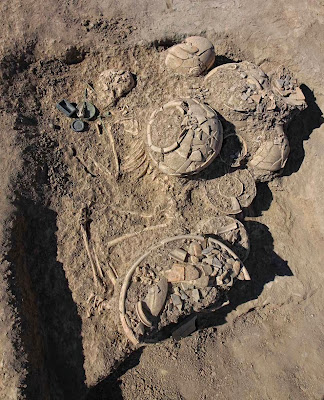Traces of BMAC culture found in NE Iran
Traces of a Bronze Age culture that is similar to the so-called Bactria–Margiana Archaeological Complex or BMAC (also known as the Oxus civilization) have been discovered during an archaeological excavation in the prehistoric site of Chalo near the town of Sankhast in North Khorasan Province, Iran.
 |
| Excavations at the prehistoric site of Chalo near the town of Sankhast in North Khorasan Province, Iran [Credit: CHN/Hassan Zohuri] |
This is the second time the team has worked at the site. The first season of excavation was carried out in 2011. The team also includes experts from Italy’s Institute for Aegean and Near Eastern Studies – ICEVO.
The BMAC is the modern archaeological designation for a Bronze Age civilization of Central Asia. The civilization, which dates to ca. 2,300–1,700 BC, was located in present day northern Afghanistan, eastern Turkmenistan, southern Uzbekistan and western Tajikistan, centered on the upper Amu Darya (Oxus River).
Its sites were discovered and named by the Soviet archaeologist Viktor Sarianidi in 1976. Bactria was the Greek name for the area of Bactra (modern Balkh), in what is now northern Afghanistan, and Margiana was the Greek name for the Persian satrapy of Margu, the capital of which was Merv, in modern-day southeastern Turkmenistan.
Sarianidi’s excavations from the late 1970s onward revealed numerous monumental structures at many sites, fortified by impressive walls and gates.
“In the first season of excavation, we found some ornamental artifacts that had surfaced as a result of agricultural activities by the locals,” Vahdati said.
Sarianidi’s excavations from the late 1970s onward revealed numerous monumental structures at many sites, fortified by impressive walls and gates.
“In the first season of excavation, we found some ornamental artifacts that had surfaced as a result of agricultural activities by the locals,” Vahdati said.
 |
| A skeleton recently discovered by the team of Iranian and Italian archaeologists at the Bronze Age site of Chalo in northeastern Iran [Credit: CHN/Hassan Zohuri] |
“Based on previous studies, the BMAC was only limited to the sites located in Central Asia: in present day northern Afghanistan, eastern Turkmenistan, and some regions in Tajikistan, but the first season of excavation showed that the Chalo site is also part of this great culture,” he added.
The team identified residential areas, a storage space, and a cemetery during the second season of excavation. To gather more information about the culture, the archaeologists dug 14 trenches in the cemetery.
“In most of the trenches, we discovered graves exhibiting signs of the BMAC. Environmental factors have caused serious damage to the graves, which have been discovered in upper layers of the ground,” Vahdati stated.
The team identified residential areas, a storage space, and a cemetery during the second season of excavation. To gather more information about the culture, the archaeologists dug 14 trenches in the cemetery.
“In most of the trenches, we discovered graves exhibiting signs of the BMAC. Environmental factors have caused serious damage to the graves, which have been discovered in upper layers of the ground,” Vahdati stated.
 |
| Storage jars from a grave unearthed by the team of Iranian and Italian archaeologists at the Bronze Age site of Chalo in northeastern Iran [Credit: CHN/Hassan Zohuri] |
All the skeletons that were unearthed lay on their right sides in an east-west position.
“A variety of stoneware, earthenware, stone and metal ornaments has been discovered in the graves. All bodies had been buried with metal bracelets and bonze pins, which were used to fasten clothing. Most of them were buried with necklaces and earrings made of stone and bone,” he said.
“All the artifacts unearthed from the graves have the same characteristics identified for the BMAC in Central Asia,” he added.
“A variety of stoneware, earthenware, stone and metal ornaments has been discovered in the graves. All bodies had been buried with metal bracelets and bonze pins, which were used to fasten clothing. Most of them were buried with necklaces and earrings made of stone and bone,” he said.
“All the artifacts unearthed from the graves have the same characteristics identified for the BMAC in Central Asia,” he added.
The artifacts bear designs of dragons, snakes, scorpions, and other animal motifs. Vahdati said people had inhabited the area before it was converted into a cemetery.
“Storage spaces dating back to 3,700 BC have been discovered at the site. Large pots which were used for storing grains and other agricultural products have been dug out in the spaces,” he added.
“We have found seeds of grain, barley and grapes. The grapes were likely used for production of vinegar or a special drink,” he stated.
Vahdati said, “Chalo reveals details of the BMAC in Iran. Maybe it is better to call it the Greater Khorasan culture, because parts of Merv, Samarkand, and Bukhara were under the influence of Greater Khorasan.”
“Storage spaces dating back to 3,700 BC have been discovered at the site. Large pots which were used for storing grains and other agricultural products have been dug out in the spaces,” he added.
“We have found seeds of grain, barley and grapes. The grapes were likely used for production of vinegar or a special drink,” he stated.
Vahdati said, “Chalo reveals details of the BMAC in Iran. Maybe it is better to call it the Greater Khorasan culture, because parts of Merv, Samarkand, and Bukhara were under the influence of Greater Khorasan.”
Source: Tehran Times [November 17, 2013]

